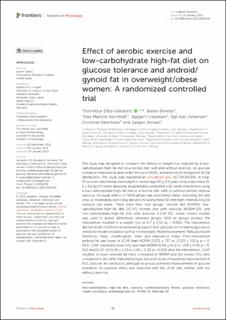Effect of aerobic exercise and low-carbohydrate high-fat diet on glucose tolerance and android/gynoid fat in overweight/obese women: A randomized controlled trial
Valsdottir, Thorhildur Ditta; Øvrebø, Bente; Kornfeldt, Thea Martine; Litleskare, Sigbjørn; Johansen, Egil Ivar; Henriksen, Christine; Jensen, Jørgen
Peer reviewed, Journal article
Published version
Permanent lenke
https://hdl.handle.net/11250/3095658Utgivelsesdato
2023Metadata
Vis full innførselSamlinger
Sammendrag
The study was designed to compare the effects of weight loss induced by a low-carbohydrate-high-fat diet or a normal diet, with and without exercise, on glucose tolerance measured as area under the curve (AUC), and android (A) and gynoid (G) fat distribution. The study was registered at clinicaltrials.gov; NCT04100356. In total, 57 women classified as overweight or obese (age 40 ± 3.5 years, body mass index 31.1 ± 2.6 kg/m2) were randomly assigned and completed a 10-week intervention using a low-carbohydrate high-fat diet or a normal diet, with or without aerobic interval exercise. An equal deficit of 700 kcal/day was prescribed, either restricting the diet only, or moderately restricting diet and including three 50-min high-intensity bicycle sessions per week. There were thus four groups: normal diet (NORM); low-carbohydrate-high-fat diet (LCHF); normal diet with exercise (NORM-EX); and low-carbohydrate-high-fat diet with exercise (LCHF-EX). Linear mixed models was used to assess differences between groups. With all groups pooled, the intervention resulted in a weight loss of 6.7 ± 2.5% (p < 0.001). The intervention did not result in differences between groups in AUC glucose, nor in fasting glucose or indicis for insulin resistance such as Homeostatic Model Assessment, Matsuda Insulin Sensitivity Index, insulinogenic index and disposition index. Post-intervention android fat was lower in LCHF than NORM (3,223 ± 727 vs. 2,533 ± 535 g, p = 0.041). LCHF reached a lower A/G ratio than NORM (0.94 ± 0.12 vs. 1.04 ± 0.09, p = 0.011) and LCHF-EX (0.94 ± 0.12 vs. 1.09 ± 0.09, p < 0.001) after the intervention. LCHF resulted in lower android fat mass compared to NORM and the lowest A/G ratio compared to the other matched groups, but with no accompanying improvement in AUC glucose. In conclusion, although all groups achieved improvements in glucose tolerance, no superior effect was observed with the LCHF diet, neither with nor without exercise.

